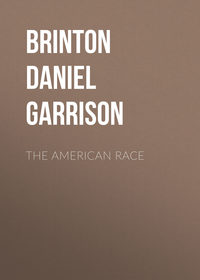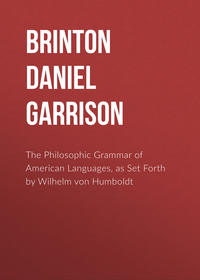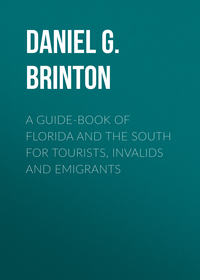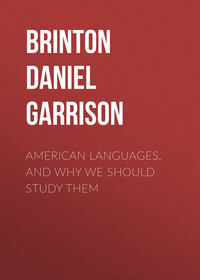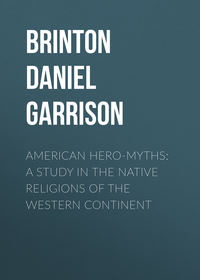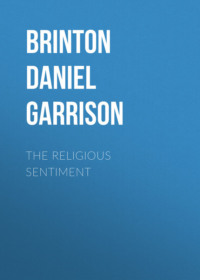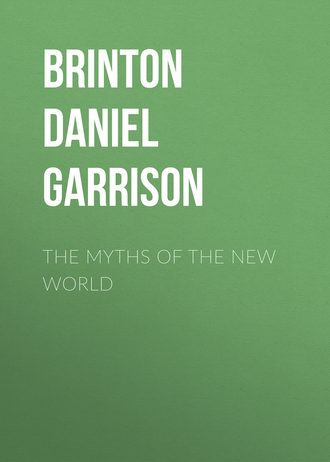 полная версия
полная версияThe Myths of the New World
This practice was almost universal. East of the Mississippi nearly every nation was accustomed, at stated periods—usually once in eight or ten years—to collect and clean the osseous remains of those of its number who had died in the intervening time, and inter them in one common sepulchre, lined with choice furs, and marked with a mound of wood, stone, and earth. Such is the origin of those immense tumuli filled with the mortal remains of nations and generations which the antiquary, with irreverent curiosity, so frequently chances upon in all portions of our territory. Throughout Central America the same usage obtained in various localities, as early writers and existing monuments abundantly testify. Instead of interring the bones, were they those of some distinguished chieftain, they were deposited in the temples or the council-houses, usually in small chests of canes or splints. Such were the charnel-houses which the historians of De Soto’s expedition so often mention, and these are the “arks” which Adair and other authors, who have sought to trace the descent of the Indians from the Jews, have likened to that which the ancient Israelites bore with them on their migrations. A widow among the Tahkalis was obliged to carry the bones of her deceased husband wherever she went for four years, preserving them in such a casket handsomely decorated with feathers.395 The Caribs of the mainland adopted the custom for all without exception. About a year after death the bones were cleaned, bleached, painted, wrapped in odorous balsams, placed in a wicker basket, and kept suspended from the door of their dwellings.396 When the quantity of these heirlooms became burdensome, they were removed to some inaccessible cavern, and stowed away with reverential care. Such was the cave Ataruipe, a visit to which has been so eloquently described by Alexander von Humboldt in his “Views of Nature.”
So great was the filial respect for these remains by the Indians, that on the Mississippi, in Peru, and elsewhere, no tyranny, no cruelty, so embittered the indigenes against the white explorers as the sacrilegious search for treasures perpetrated among the sepulchres of past generations. Unable to understand the meaning of such deep feeling, so foreign to the European who, without a second thought, turns a cemetery into a public square, or seeds it down in wheat, the Jesuit missionaries in Paraguay accuse the natives of worshipping the skeletons of their forefathers,397 and the English in Virginia repeated it of the Powhatans.
The question has been debated and variously answered, whether the art of mummification was known and practised in America. Without entering into the discussion, it is certain that preservation of the corpse by a long and thorough process of exsiccation over a slow fire was nothing unusual, not only in Peru, Popoyan, the Carib countries, and Nicaragua, but among many of the tribes north of the Gulf of Mexico, as I have elsewhere shown.398 The object was essentially the same as when the bones alone were preserved; and in the case of rulers, the same homage was often paid to their corpses as had been the just due of their living bodies.
The opinion underlying all these customs was, that a part of the soul, or one of the souls, dwelt in the bones; that these were the seeds which, planted in the earth, or preserved unbroken in safe places, would, in time, put on once again a garb of flesh, and germinate into living human beings. Language illustrates this not unusual theory. The Iroquois word for bone is esken—for soul, atisken, literally that which is within the bone.399 In an Athapascan dialect bone is yani, soul i-yune.400 The Hebrew Rabbis taught that in the bone lutz, the coccyx, remained at death the germ of a second life, which, at the proper time, would develop into the purified body, as the plant from the seed.
But mythology and supersitions add more decisive testimony. One of the Aztec legends of the origin of man was, that after one of the destructions of the world the gods took counsel together how to renew the species. It was decided that one of their number, Xolotl, should descend to Mictlan, the realm of the dead, and bring thence a bone of the perished race. The fragments of this they sprinkled with blood, and on the fourth day it grew into a youth, the father of the present race.401 The profound mystical significance of this legend is reflected in one told by the Quichés, in which the hero gods Hunahpu and Xblanque succumb to the rulers of Xibalba, the darksome powers of death. Their bodies are burned, but their bones are ground in a mill and thrown in the waters, lest they should come to life. Even this precaution is insufficient—“for these ashes did not go far; they sank to the bottom of the stream, where, in the twinkling of an eye, they were changed into handsome youths, and their very same features appeared anew. On the fifth day they displayed themselves anew, and were seen in the water by the people,”402 whence they emerged to overcome and destroy the powers of death and hell (Xibalba).
The strongest analogies to these myths are offered by the superstitious rites of distant tribes. Some of the Tupis of Brazil were wont on the death of a relative to dry and pulverize his bones and then mix them with their food, a nauseous practice they defended by asserting that the soul of the dead remained in the bones and lived again in the living.403 Even the lower animals were supposed to follow the same law. Hardly any of the hunting tribes, before their original manners were vitiated by foreign influence, permitted the bones of game slain in the chase to be broken, or left carelessly about the encampment. They were collected in heaps, or thrown into the water. Mrs. Eastman observes that even yet the Dakotas deem it an omen of ill luck in the hunt, if the dogs gnaw the bones or a woman inadvertently steps over them; and the Chipeway interpreter, John Tanner, speaks of the same fear among that tribe. The Yurucares of Bolivia carried it to such an inconvenient extent, that they carefully put by even small fish bones, saying that unless this was done the fish and game would disappear from the country.404 The traveller on our western prairies often notices the buffalo skulls, countless numbers of which bleach on those vast plains, arranged in circles and symmetrical piles by the careful hands of the native hunters. The explanation they offer for this custom gives the key to the whole theory and practice of preserving the osseous relics of the dead, as well human as brute. They say that, “the bones contain the spirits of the slain animals, and that some time in the future they will rise from the earth, re-clothe themselves with flesh, and stock the prairies anew.”405 This explanation, which comes to us from indisputable authority, sets forth in its true light the belief of the red race in a resurrection. It is not possible to trace it out in the subtleties with which theologians have surrounded it as a dogma. The very attempt would be absurd. They never occurred to the Indian. He thought that the soul now enjoying the delights of the happy hunting grounds would some time return to the bones, take on flesh, and live again. Such is precisely the much discussed statement that Garcilasso de la Vega says he often heard from the native Peruvians. He adds that so careful were they lest any of the body should be lost that they preserved even the parings of their nails and clippings of the hair.406 In contradiction to this the writer Acosta has been quoted, who says that the Peruvians embalmed their dead because they “had no knowledge that the bodies should rise with the soul.”407 But, rightly understood, this is a confirmation of La Vega’s account. Acosta means that the Christian doctrine of the body rising from the dust being unknown to the Peruvians (which is perfectly true), they preserved the body just as it was, so that the soul when it returned to earth, as all expected, might not be at a loss for a house of flesh.
The notions thus entertained by the red race on the resurrection are peculiar to it, and stand apart from those of any other. They did not look for the second life to be either better or worse than the present one; they regarded it neither as a reward nor a punishment to be sent back to the world of the living; nor is there satisfactory evidence that it was ever distinctly connected with a moral or physical theory of the destiny of the universe, or even with their prevalent expectation of recurrent epochs in the course of nature. It is true that a writer whose personal veracity is above all doubt, Mr. Adam Hodgson, relates an ancient tradition of the Choctaws, to the effect that the present world will be consumed by a general conflagration, after which it will be reformed pleasanter than it now is, and that then the spirits of the dead will return to the bones in the bone mounds, flesh will knit together their loose joints, and they shall again inhabit their ancient territory.408
There was also a similar belief among the Eskimos. They said that in the course of time the waters would overwhelm the land, purify it of the blood of the dead, melt the icebergs, and wash away the steep rocks. A wind would then drive off the waters, and the new land would be peopled by reindeers and young seals. Then would He above blow once on the bones of the men and twice on those of the women, whereupon they would at once start into life, and lead thereafter a joyous existence.409
But though there is nothing in these narratives alien to the course of thought in the native mind, yet as the date of the first is recent (1820), as they are not supported (so far as I know) by similar traditions elsewhere, and as they may have arisen from Christian doctrines of a millennium, I leave them for future investigation.
What strikes us the most in this analysis of the opinions entertained by the red race on a future life is the clear and positive hope of a hereafter, in such strong contrast to the feeble and vague notions of the ancient Israelites, Greeks, and Romans, and yet the entire inertness of this hope in leading them to a purer moral life. It offers another proof that the fulfilment of duty is in its nature nowise connected with or derived from a consideration of ultimate personal consequences. It is another evidence that the religious is wholly distinct from the moral sentiment, and that the origin of ethics is not to be sought in connection with the ideas of divinity and responsibility.
CHAPTER X.
THE NATIVE PRIESTHOOD
Their titles.—Practitioners of the healing art by supernatural means.—Their power derived from natural magic and the exercise of the clairvoyant and mesmeric faculties.—Examples.—Epidemic hysteria.—Their social position.—Their duties as religious functionaries.—Terms of admission to the Priesthood.—Inner organization in various nations.—Their esoteric languages and secret societies.
THUS picking painfully amid the ruins of a race gone to wreck centuries ago, thus rejecting much foreign rubbish and scrutinizing each stone that lies around, if we still are unable to rebuild the edifice in its pristine symmetry and beauty, yet we can at least discern and trace the ground plan and outlines of the fane it raised to God. Before leaving the field to the richer returns of more fortunate workmen, it will not be inappropriate to add a sketch of the ministers of these religions, the servants in this temple.
Shamans, conjurers, sorcerers, medicine men, wizards, and many another hard name have been given them, but I shall call them priests, for in their poor way, as well as any other priesthood, they set up to be the agents of the gods, and the interpreters of divinity. No tribe was so devoid of religious sentiment as to be without them. Their power was terrible, and their use of it unscrupulous. Neither men nor gods, death nor life, the winds nor the waves, were beyond their control. Like Old Men of the Sea, they have clung to the neck of their nations, throttling all attempts at progress, binding them to the thraldom of superstition and profligacy, dragging them down to wretchedness and death. Christianity and civilization meet in them their most determined, most implacable foes. But what is this but the story of priestcraft and intolerance everywhere, which Old Spain can repeat as well as New Spain, the white race as well as the red? Blind leaders of the blind, dupers and duped fall into the ditch.
In their own languages they are variously called; by the Algonkins and Dakotas, “those knowing divine things” and “dreamers of the gods” (manitousiou, wakanwacipi); in Mexico, “masters or guardians of the divine things” (teopixqui, teotecuhtli); in Cherokee, their title means, “possessed of the divine fire” (atsilung kelawhi); in Iroquois, “keepers of the faith” (honundeunt); in Quichua, “the learned” (amauta); in Maya, “the listeners” (cocome). The popular term in French and English of “medicine men” is not such a misnomer as might be supposed. The noble science of medicine is connected with divinity not only by the rudest savage but the profoundest philosopher, as has been already adverted to. When sickness is looked upon as the effect of the anger of a god, or as the malicious infliction of a sorcerer, it is natural to seek help from those who assume to control the unseen world, and influence the fiats of the Almighty. The recovery from disease is the kindliest exhibition of divine power. Therefore the earliest canons of medicine in India and Egypt are attributed to no less distinguished authors than the gods Brahma and Thoth;410 therefore the earliest practitioners of the healing art are universally the ministers of religion.
But, however creditable this origin is to medicine, its partnership with theology was no particular advantage to it. These mystical doctors shared the contempt still so prevalent among ourselves for a treatment based on experiment and reason, and regarded the administration of emetics and purgatives, baths and diuretics, with a contempt quite equal to that of the disciples of Hahnemann. The practitioners of the rational school formed a separate class among the Indians, and had nothing to do with amulets, powwows, or spirits.411 They were of different name and standing, and though held in less estimation, such valuable additions to the pharmacopœia as guaiacum, cinchona, and ipecacuanha, were learned from them. The priesthood scorned such ignoble means. Were they summoned to a patient, they drowned his groans in a barbarous clangor of instruments in order to fright away the demon that possessed him; they sucked and blew upon the diseased organ, they sprinkled him with water, and catching it again threw it on the ground, thus drowning out the disease; they rubbed the part with their hands, and exhibiting a bone or splinter asserted that they drew it from the body, and that it had been the cause of the malady, they manufactured a little image to represent the spirit of sickness, and spitefully knocked it to pieces, thus vicariously destroying its prototype; they sang doleful and monotonous chants at the top of their voices, screwed their countenances into hideous grimaces, twisted their bodies into unheard of contortions, and by all accounts did their utmost to merit the honorarium they demanded for their services. A double motive spurred them to spare no pains. For if they failed, not only was their reputation gone, but the next expert called in was likely enough to hint, with that urbanity so traditional in the profession, that the illness was in fact caused or much increased by the antagonistic nature of the remedies previously employed, whereupon the chances were that the doctor’s life fell into greater jeopardy than that of his quondam patient.
Considering the probable result of this treatment, we may be allowed to doubt whether it redounded on the whole very much to the honor of the fraternity. Their strong points are rather to be looked for in the real knowledge gained by a solitary and reflective life, by an earnest study of the appearances of nature, and of those hints and forest signs which are wholly lost on the white man and beyond the ordinary insight of a native. Travellers often tell of changes of the weather predicted by them with astonishing foresight, and of information of singular accuracy and extent gleaned from most meagre materials. There is nothing in this to shock our sense of probability—much to elevate our opinion of the native sagacity. They were also adepts in tricks of sleight of hand, and had no mean acquaintance with what is called natural magic. They would allow themselves to be tied hand and foot with knots innumerable, and at a sign would shake them loose as so many wisps of straw; they would spit fire and swallow hot coals, pick glowing stones from the flames, walk naked through a fire, and plunge their arms to the shoulder in kettles of boiling water with apparent impunity.412 Nor was this all. With a skill not inferior to that of the jugglers of India, they could plunge knives into vital parts, vomit blood, or kill one another out and out to all appearances, and yet in a few minutes be as well as ever; they could set fire to articles of clothing and even houses, and by a touch of their magic restore them instantly as perfect as before.413 If it were not within our power to see most of these miracles performed any night in one of our great cities by a well dressed professional, we would at once deny their possibility. As it is, they astonish us only too little.
One of the most peculiar and characteristic exhibitions of their power, was to summon a spirit to answer inquiries concerning the future and the absent. A great similarity marked this proceeding in all northern tribes from the Eskimos to the Mexicans. A circular or conical lodge of stout poles four or eight in number planted firmly in the ground, was covered with skins or mats, a small aperture only being left for the seer to enter. Once in, he carefully closed the hole and commenced his incantations. Soon the lodge trembles, the strong poles shake and bend as with the united strength of a dozen men, and strange, unearthly sounds, now far aloft in the air, now deep in the ground, anon approaching near and nearer, reach the ears of the spectators. At length the priest announces that the spirit is present, and is prepared to answer questions. An indispensable preliminary to any inquiry is to insert a handful of tobacco, or a string of beads, or some such douceur under the skins, ostensibly for the behoof of the celestial visitor, who would seem not to be above earthly wants and vanities. The replies received, though occasionally singularly clear and correct, are usually of that profoundly ambiguous purport which leaves the anxious inquirer little wiser than he was before. For all this, ventriloquism, trickery, and shrewd knavery are sufficient explanations. Nor does it materially interfere with this view, that converted Indians, on whose veracity we can implicitly rely, have repeatedly averred that in performing this rite they themselves did not move the medicine lodge; for nothing is easier than in the state of nervous excitement they were then in to be self-deceived, as the now familiar phenomenon of table-turning illustrates.
But there is something more than these vulgar arts now and then to be perceived. There are statements supported by unquestionable testimony, which ought not to be passed over in silence, and yet I cannot but approach them with hesitation. They are so revolting to the laws of exact science, so alien, I had almost said, to the experience of our lives. Yet is this true, or are such experiences only ignored and put aside without serious consideration? Are there not in the history of each of us passages which strike our retrospective thought with awe, almost with terror? Are there not in nearly every community individuals who possess a mysterious power, concerning whose origin, mode of action, and limits, we and they are alike in the dark? I refer to such organic forces as are popularly summed up under the words clairvoyance, mesmerism, rhabdomancy, animal magnetism, physical spiritualism. Civilized thousands stake their faith and hope here and hereafter, on the truths of these manifestations; rational medicine recognizes their existence, and while it attributes them to morbid and exceptional influences, confesses its want of more exact knowledge, and refrains from barren theorizing. Let us follow her example, and hold it enough to show that such powers, whatever they are, were known to the native priesthood as well as the modern spiritualists, and the miracle mongers of the Middle Ages.
Their highest development is what our ancestors called “second sight.” That under certain conditions knowledge can pass from one mind to another otherwise than through the ordinary channels of the senses, is familiarly shown by the examples of persons en rapport. The limit to this we do not know, but it is not unlikely that clairvoyance or second sight is based upon it. In his autobiography, the celebrated Sac chief Black Hawk, relates that his great grandfather “was inspired by a belief that at the end of four years, he should see a white man, who would be to him a father.” Under the direction of this vision he travelled eastward to a certain spot, and there, as he was forewarned, met a Frenchman, through whom the nation was brought into alliance with France.414 No one at all versed in the Indian character will doubt the implicit faith with which this legend was told and heard. But we may be pardoned our scepticism, seeing there are so many chances of error. It is not so with an anecdote related by Captain Jonathan Carver, a cool-headed English trader, whose little book of travels is an unquestioned authority. In 1767, he was among the Killistenoes at a time when they were in great straits for food, and depending upon the arrival of the traders to rescue them from starvation. They persuaded the chief priest to consult the divinities as to when the relief would arrive. After the usual preliminaries, this magnate announced that next day, precisely when the sun reached the zenith, a canoe would arrive with further tidings. At the appointed hour the whole village, together with the incredulous Englishman, was on the beach, and sure enough, at the minute specified, a canoe swung round a distant point of land, and rapidly approaching the shore brought the expected news.415
Charlevoix is nearly as trustworthy a writer as Carver. Yet he deliberately relates an equally singular instance.416
But these examples are surpassed by one described in the Atlantic Monthly of July, 1866, the author of which, John Mason Brown, Esq., has assured me of its accuracy in every particular. Some years since, at the head of a party of voyageurs, he set forth in search of a band of Indians somewhere on the vast plains along the tributaries of the Copper-mine and Mackenzie rivers. Danger, disappointment, and the fatigues of the road, induced one after another to turn back, until of the original ten only three remained. They also were on the point of giving up the apparently hopeless quest, when they were met by some warriors of the very band they were seeking. These had been sent out by one of their medicine men to find three whites, whose horses, arms, attire, and personal appearance he minutely described, which description was repeated to Mr. Brown by the warriors before they saw his two companions. When afterwards, the priest, a frank and simple-minded man, was asked to explain this extraordinary occurrence, he could offer no other explanation than that “he saw them coming, and heard them talk on their journey.”417
Many tales such as these have been recorded by travellers, and however much they may shock our sense of probability, as well-authenticated exhibitions of a power which sways the Indian mind, and which has ever prejudiced it so unchangeably against Christianity and civilization, they cannot be disregarded. Whether they too are but specimens of refined knavery, whether they are instigations of the Devil, or whether they must be classed with other facts as illustrating certain obscure and curious mental faculties, each may decide as the bent of his mind inclines him, for science makes no decision.
Those nervous conditions associated with the name of Mesmer were nothing new to the Indian magicians. Rubbing and stroking the sick, and the laying on of hands, were very common parts of their clinical procedures, and at the initiations to their societies they were frequently exhibited. Observers have related that among the Nez Percés of Oregon, the novice was put to sleep by songs, incantations, and “certain passes of the hand,” and that with the Dakotas he would be struck lightly on the breast at a preconcerted moment, and instantly “would drop prostrate on his face, his muscles rigid and quivering in every fibre.”418




